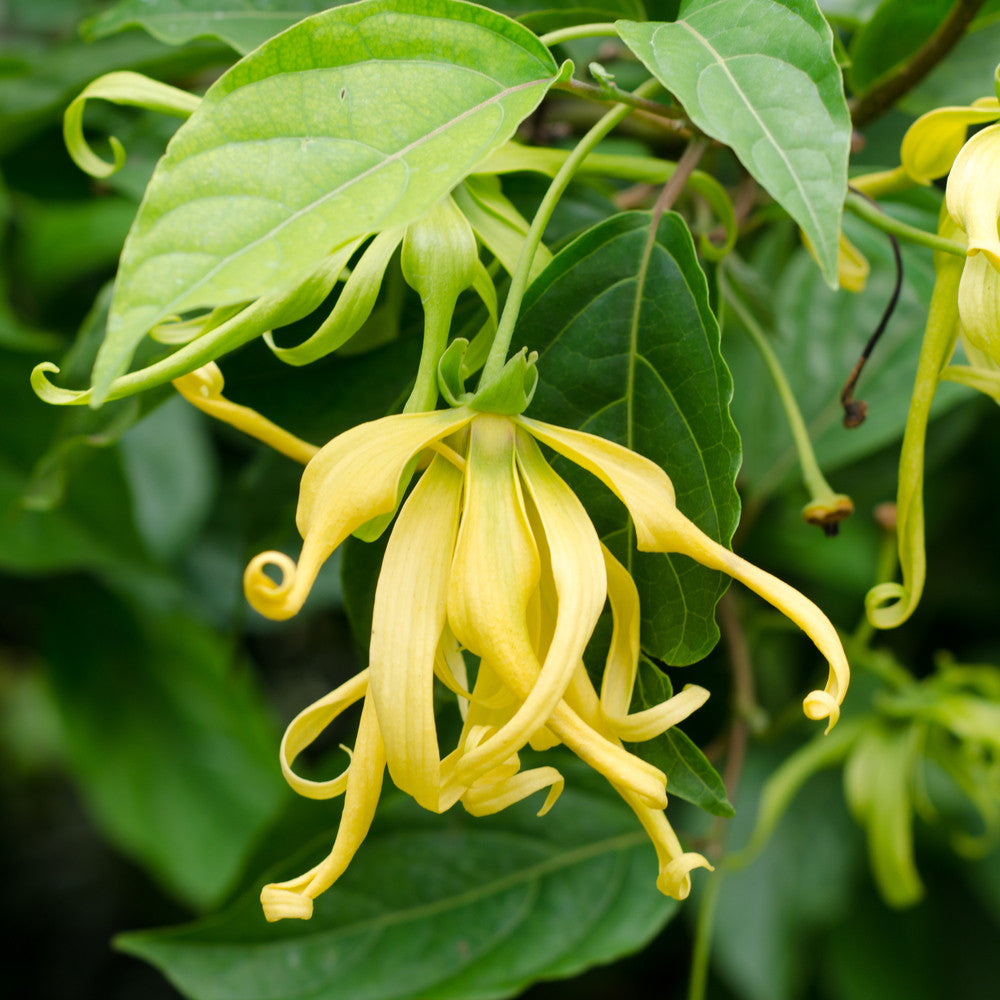TIMELESS Essential Oils
Ylang Ylang #2, Organic
Couldn't load pickup availability
Pure, Therapeutic Ylang Ylang #2, Organically Grown
Product Details
Botanical name
Cananga odorata genuina
Extraction method / Source
Steam Distillation / Flowers
Ylang Ylang #2 is the essential oil drawn from the second hour of the distillation process, and varies somewhat in its constituents from Extra, which contains all the components of distillation.
Aroma
Sweet, heavy, tropical floral with spicy balsamic undertones
Note classification
Middle / Base
Odor Intensity
4
Key constituents
Linalool, Germacrene, Caryophyllene, p-cresyl ether, methyl benzoate, Sesquiterpenes
Plant description
Botanical family: Annonaceae (Custard apple)
Cananga tree is a tropical evergreen tree indigenous to the Philippines, and has been naturalized to several tropical areas.. It grows to a height of 40 feet and produces smooth, glossy leaves with wavy edges and highly fragrant yellow flowers which droop. The tree is also known as Macassar oil tree and Perfume tree. The essential oil derived from the canaga flowers is referred to as Ylang Ylang. It is sometimes confused with the Ylang Ylang plant, Artabotrys odorissimus, which is an evergreen climbing vine in the same family, and is also used to make perfume.
Regions of Production
Madagascar
Growing Practices
Organically farmed. Plants are tested for purity after harvest.
History / Fun Facts
In the Philippines canaga flowers are strung into necklaces worn by women. In Indonesia, the fragrant flowers are spread on the bed of newlyweds.
Properties
Anti-anxiety, aphrodisiac, antidepressant, lowers blood pressure, uplifting, antiseptic. (Battaglia, 2003)
Uses / Benefits
Primarily used in perfume making, Ylang Ylang is also used to help lower blood pressure and normalize sebum secretion to help treat skin disorders such as acne.
Fragrant influences
Aphrodisiac, euphoric, uplifting
Modes of Administration
Topical: massage, compress, skin care
Inhalation: direct inhalation, diffuser, oil vaporizer
Blends well with
Bergamot, Roman Chamomile, Clary Sage, Clove, Eucalyptus Lemon, Ginger, Pink Grapefruit, Jasmine, Lemon, Mandarin, May Chang, Sweet Orange, Palmarosa, Patchouli, Petitgrain, Rose, Sandalwood, Vetiver
Safety
Nontoxic
Notice
This information is for educational purposes only. It has not been evaluated by the US Food and Drug Administration. It is not intended to diagnose, treat, cure or prevent any condition or disease. Although we strive to provide information which is accurate and up to date, we cannot guarantee the accuracy or completeness of this information.
Precautions
Pure essential oils are highly concentrated plant extracts. Do not use them undiluted, or in the eyes or mucus membranes. If applying an essential oil to the skin, always dilute it with a proper carrier oil and test on a small patch of skin before applying to a large area. Do not take them internally except under the direction of a qualified professional trained in Aromatherapy. Always familiarize yourself with the safety, contraindications and proper preparation of each essential oil before use. Note that when using essential oils for children and the elderly, very low concentrations should be used. Keep all essential oils away from children and pets.
References
Althea Press, Essential Oils: Natural Remedies, 2015. Althea Press, Berkeley, CA.
Battaglia, Salvatore, The Complete Guide to Aromatherapy, Second Edition, 2003. The International Centre of Holistic Aromatherapy, Brisbane, Australia
Cooksley, Valerie Gennari, Aromatherapy: Soothing Remedies to Restore, Rejuvenate, and Heal, 2002. Prentice Hall Press, New York, NY.
Cooksley, Valerie Gennari, Aromatherapy : A Holistic Guide to Natural Healing with Essential Oils, 2015. Floramed Publishing, The Woodlands, TX.
Falconi, Dina, Earthly Bodies and Heavenly Hair : Natural and Healthy Personal Care for Every Body, 1998. Ceres Press, Woodstock, NY.
Green, Mindy, Natural Perfumes, 1999. Interweave Press, Loveland, CO.
Halpern, Georges M., M.D., Ph.D., Weverka, Peter, The Healing Trail: Essential Oils of Madagascar, 2003, Basic Health Publications, Inc., North Bergen, NJ.
International Fragrance Research Association, http://www.ifraorg.org/en-us/standards (January 5, 2016).
Schnaubelt, Kurt, Advanced Aromatherapy: The Science of Essential Oil Therapy, (English translation)1998. Healing Arts Press, Rochester, VT.
Schnaubelt, Kurt, The Healing Intelligence of Essential Oils: The Science of Aromatherapy, 2011. Healing Arts Press, Rochester, VT.
United States Food and Drug Administration, HHS, 182.1 Substances That Are Generally Recognized as Safe, 182.20 Essential oils, Oleoresins (solvent-free), and natural extractives (including distillates), http://www.gpo.gov/fdsys/CFR-2012-title21-vol3-sec182 (January 28, 2016).
TIMELESS Essential Oils guarantees the purity and quality of all our therapeutic oils. The current Certificate of Analysis is available upon request. All essential oils are best stored in an airtight container away from heat and light.


